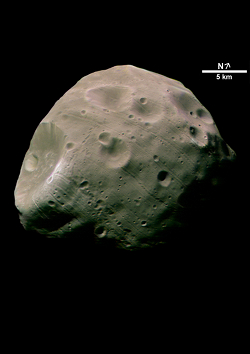Mars Express science highlights: #10. Mapping and measuring Phobos in unprecedented detail
 |
|
An image of the Mars-facing side of Phobos. Credit: ESA/DLR/FU Berlin (G. Neukum) |
These remarkably close flybys provided exquisitely detailed images of most of Phobos, in particular the side that faces away from Mars. (Like Earth’s Moon, Phobos always keeps the same face towards its planet.) These were used to image the proposed landing site for the Russian Phobos-Grunt spacecraft, which was unfortunately lost soon after launch. They also enabled scientists to create the most precise 3D model of the moon so far constructed, from which they were able to measure its volume.
Its proximity to Phobos also meant that the moon’s minuscule gravity tugged very slightly on the spacecraft, altering its velocity by just a few millimetres per second. Mission controllers on Earth succeeded in identifying its effect on the radio tracking signal - a variation of just one part in a trillion on the carrier signal.
This incredible achievement allowed Phobos' mass to be measured 100 times more accurately than before. Although the volume calculation was much less certain than the mass, it was possible to derive the best-ever estimate of the moon’s average density. What emerged led to an entirely new understanding of Phobos’ structure and origin.
The mean density was found to be unexpectedly low - only 1.86 g per cubic cm – indicating that it may be a porous body rather than a single chunk of solid rock. If it is a captured asteroid, the material it is made from must be less dense than primitive chondritic (carbon-rich) rock, making the empty fraction likely to be around 15 per cent of the volume. If the moon is made of the equivalent of martian rocks, however, then Phobos' void area must be much higher: up to 45 per cent.
Meanwhile, measurements of Phobos’ surface composition, made by the Planetary Fourier Spectrometer (PFS), are consistent with the presence of phyllosilicate minerals on the surface of Phobos, particularly near Stickney, its largest impact crater. This implies the interaction of silicate materials with liquid water.
For many years, the favoured explanation for the origin of the martian moons was that they were captured asteroids. However, a highly porous asteroid would probably not have survived such a capture process. The new density and mineral composition data support an alternative theory, in which Phobos was assembled in Mars orbit during re-accretion of rocky material. It seems that a giant impact on the planet may have thrown large chunks of debris into orbit. These eventually came together and settled against one another at haphazard angles, forming the loose agglomeration we now call Phobos.
In another first, Mars Express, caught both martian moons, Phobos and Deimos, on camera as the larger moon passed in front of its more distant cousin. The images were acquired with the Super Resolution Channel of the High Resolution Stereo Camera (HRSC). The camera took 130 images of the moons on 5 November 2009 over period of 1.5 minutes. The unique movie was used to validate and refine existing orbit models of the two moons.
